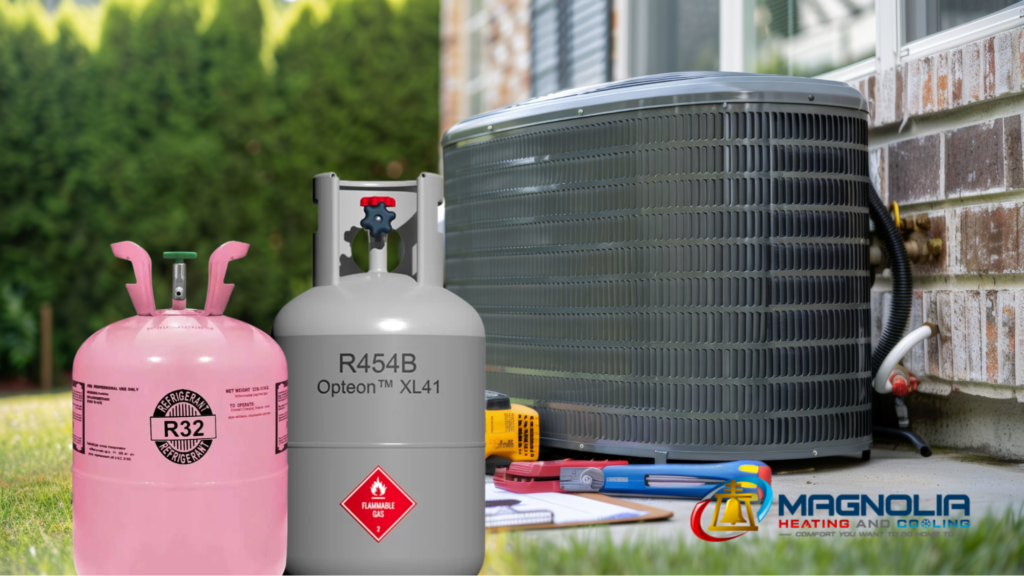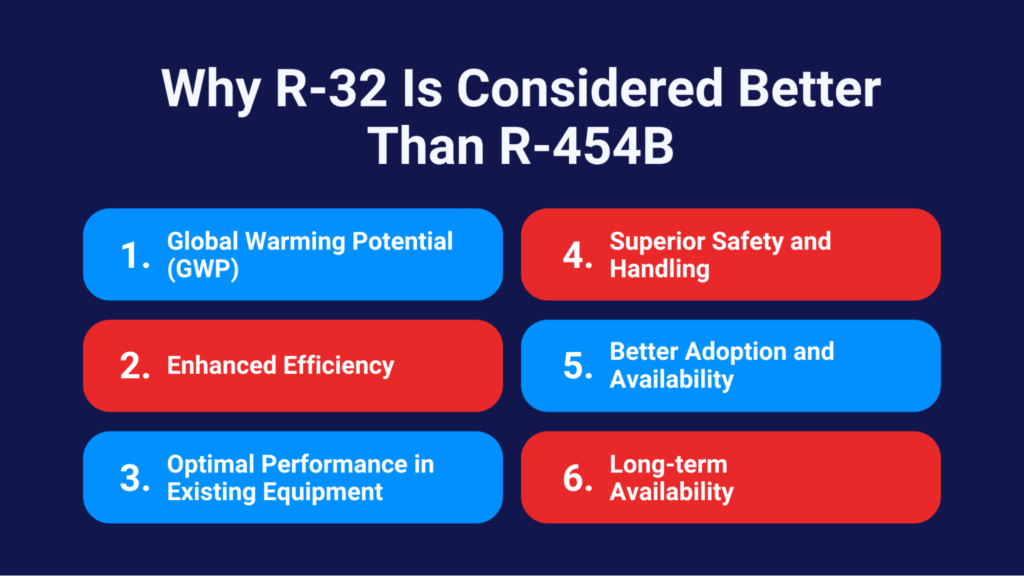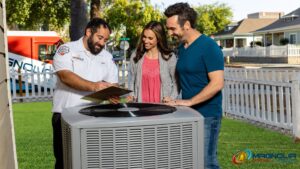
In light of the 2025 refrigerant mandate, California’s HVAC industry and consumers continue to navigate the complex world of refrigerant transitions. This leaves many professionals and property owners at a fork in the road between R-32 and R-454B options.
Much of this debate focuses on the refrigerant’s Global Warming Potential (GWP) values—an essential but singular metric. However, in actuality, the complete picture of R-32 vs. R-454B involves various factors that impact performance, cost-effectiveness, and environmental impact.
At Magnolia Heating and Cooling, we’re here to help with our complete guide to understanding the topic. In this guide, we’ll explore R-32 vs. R-454B efficiency beyond environmental ratings, how to examine efficiency metrics, and more for forward-thinking California property owners.
Read on to learn about HVAC refrigerants and make the best choice.
Understanding R-32 and R-454B
As directed by California’s new 2025 refrigerant mandate, R-32 and R-454B are the two approved refrigerants. Let’s first examine the key distinctions between the two to determine which is best for your property and HVAC needs.
R-32 (difluoromethane) is a single-component refrigerant gaining significant traction in the HVAC industry thanks to its relatively lower GWP. Because it’s a pure compound rather than a blend, R-32 offers consistent temperature glide properties during phase changes. This trait tends to provide a more predictable performance across various operating conditions.
R-454B, on the other hand, is a zeotropic blend consisting of 68.9% R-32 and 31.1% R-1234yf. This specially made mixture was created as an alternative to the more common R-410A. Its goal is to strike a balance between performance and environmental concerns. Next, let’s dive deeper into the differences.
Why R-32 Is Considered Better Than R-454B

Now that you know more about R-32 and R-454B individually, let’s understand why R-32 is considered the best GWP refrigerant.
- Global Warming Potential (GWP)
Even though R-454B has a slightly lower GWP rating of 466 compared to R-32’s 675, this slight advantage in one rating becomes less significant when weighing the efficiency of a lifetime system performance. Because R-32 has superior efficiency compared to R-454B, it uses less energy consumption over the equipment’s entire lifespan.
Ultimately, less energy consumption leads to R-32 having a smaller carbon footprint from power generation over time. Even better, systems using R-32 need up to 30% less refrigerant charge than similar R-454B systems. This reduction more than makes up for the small difference in GWP when figuring out the total environmental impact from possible leaks.
- Efficiency
As we’ve already hinted, real-world R-32 refrigerant applications have a notably higher energy efficiency rating. In fact, some smaller in-field studies suggest 5–10% improved performance over R-454B systems under identical conditions. The efficiency advantage comes from R-32’s thermodynamic properties, supporting improved heat transfer coefficients and higher volumetric capacity.
Another factor to keep in mind is the efficiency gap widens while operating under extreme temperatures. R-32 is better able to maintain consistent performance during California’s increasingly common heat waves, when cooling systems face their greatest demands and when grid-wide energy efficiency becomes most critical.
- Performance in Existing Equipment
As for utilizing the new refrigerants in existing equipment, R-32 is more compatible for retrofitting. In comparison to R-454B, which will often experience temperature glides during phase changes that cause reduced performance and uneven cooling. On the flip side, R-32 can better maintain consistent temperatures throughout cooling cycles.
Overall, this means R-32 refrigerants are more predictable and have fewer compatibility issues with existing equipment’s valves, heat exchangers, and control systems. For homeowners, this means it can also help reduce the scope and cost of upgrades required during refrigerant transitions.
- Safety and Handling
Regarding safety and handling and R-32 vs. R-454B, both are A2L or mildly flammable. However, R-32 has been used for significantly longer in commercial spaces, meaning it has more established safety protocols and technician familiarity. These features can reduce the overall risks involved with the transition.
Being a single component, R-32 also mitigates risks of refrigerant fractionation during leaks, which can occur with blended refrigerants like R-454B, potentially altering system performance and complicating recharging procedures.
Overall, because R-32 has well-documented behaviors in multiple scenarios, technicians have more comprehensive standards and training programs to follow for handling safely.
- Adoption and Availability
Considering major manufacturers like Mitsubishi, Fujitsu, and Daikin all offer extensive equipment lines using R-32, you can guess which of the refrigerants, R-32 vs. R-454B, has achieved wider market adoption. This broader availability translates to more competitive pricing, greater equipment options, and better parts availability for California property owners.
Beyond that, R-32 is more actively deployed in the real world, exceeding 280 million installations since 2012. This wide adoption of R32 refrigerant applications has generated valuable field data validating its performance claims and reliability, providing confidence for larger commercial installations where system reliability is paramount.
- Long-term Availability
Finally, the last reason R-32 is better than R-454B is its long-term availability. Again, since it’s a single compound with a simpler chemical composition, it’s less expensive to produce and recycle than complex blends like R-454B.
For sustainable efficiency and efficacy, R-32 can be reclaimed and reused as a single-component refrigerant, without concerns about blend separation or composition changes. Major chemical manufacturers have committed to long-term R-32 production, with multiple global sources ensuring supply stability.
This production certainty, combined with established reclamation infrastructure, makes R-32 a more sustainable choice for equipment expected to operate for 15–20 years, minimizing future availability concerns and potential cost increases.
The Real Impact of GWP vs. Efficiency
While GWP does provide insight into one factor that supports sustainability (its global warming potential), it doesn’t account for other factors that improve equipment efficiency. For instance, studies show lifetime energy consumption typically accounts for 70-80% of an HVAC system’s carbon footprint, while refrigerant emissions contribute less than 20%.
This means R-32’s superior efficiency—resulting in 5-10% less energy consumption—delivers greater real-world climate benefits despite its slightly higher GWP rating. To add, R-32’s higher cooling capacity per pound means systems require less refrigerant charge, further reducing potential emissions from leaks.
When calculating total climate impact over a system’s 15-20 year lifespan, the efficiency advantage of R-32 makes it the environmentally superior choice by a significant margin.
Regulatory & Compliance Considerations
The California Air Resources Board’s (CARB) latest mandates establish a 750 GWP limit for new stationary air conditioning equipment beginning January 1, 2025, making both R-32 and R-454B compliant options. However, regulatory compliance extends beyond simple GWP values.
Equipment using R-32 has already received extensive UL certification and building code approval, streamlining permitting processes and inspections. Many local jurisdictions have updated their implementation guidelines specifically referencing R-32 systems, while R-454B may require additional documentation or review in some areas.
Finally, California’s Title 24 energy efficiency requirements increasingly favor systems with higher Seasonal Energy Efficiency Ratios (SEER2) ratings, where R-32 equipment typically outperforms alternatives, potentially providing compliance advantages for new construction and major renovations.
Performance & Practical Applications
So far, performance data from California installations appropriately demonstrates R-32’s advantages across diverse applications. In residential settings, R-32 mini-split and central systems consistently deliver superior cooling performance during high-temperature conditions common in inland California regions, with better maintenance capacity and efficiency when outdoor temperatures exceed 110°F.
Commercial applications show even more pronounced benefits, with R-32 VRF and rooftop systems demonstrating up to 12% energy savings in large retail and office environments with variable cooling demands. R-32 has proven particularly effective in:
- Multi-family residential complexes with diverse usage patterns
- Medical facilities requiring precise temperature control
- Data centers with high cooling demands and sensitivity to efficiency
- Hospitality venues needing quiet operation and reliable performance
- Educational institutions balancing budget constraints with comfort requirements
- Retail environments with fluctuating occupancy and thermal loads
The refrigerant’s excellent heat transfer properties also enable more compact system designs—particularly valuable in space-constrained applications like apartment retrofits and urban commercial properties.
Future-Proofing Your Decision: Expert Refrigerant Services from Magnolia HVAC
All in all, knowing the differences between R-32 vs. R-454B is just the start. The next step in becoming compliant with the new 2025 refrigerant mandate is to partner with professional HVAC maintenance services to make the transition and to maintain your equipment efficiently and effectively over time.
In Southern California, homeowners and property owners trust Magnolia Heating and Cooling for all their HVAC and refrigeration service needs. Magnolia HVAC has been a trusted name in the region since 1951, providing dependable, transparent, and exemplary services at fair prices.
Are you in need of assistance with HVAC refrigerants, maintenance, repairs, or installations? Look no further than Magnolia. From air conditioning installation to HVAC refrigerant installation and everything in between, we’ve got you covered! Get in touch with our team now to schedule an appointment.



